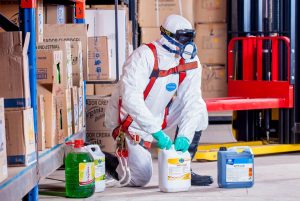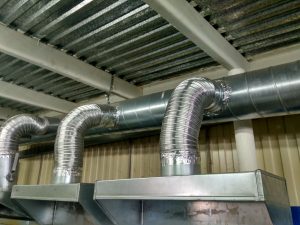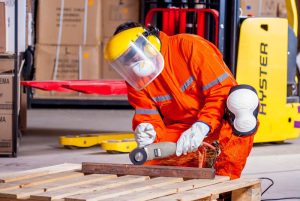Over 1.7 million workers in the UK suffered from work-related illnesses in 2022 alone. This figure highlights the critical importance of preventive measures and early detection of health risks to protect employees and ensure the smooth running of businesses.
By proactively managing these risks, companies can reduce absenteeism, improve productivity, and avoid costly legal implications.
The Importance of Prevention in the Workplace
Preventive measures are crucial for creating a safe and healthy work environment. Hazards such as prolonged exposure to harmful substances and poor air quality can lead to serious health problems over time. These risks can manifest as musculoskeletal disorders, respiratory illnesses, and occupational cancers.
By implementing preventive strategies, employers can mitigate risks before they become serious threats.
Steps for effective preventative measures
The benefits of early detection and prevention
Proactively managing health risks in the workplace provides numerous benefits, both for employees and employers. Some of these include:
Reduced Absenteeism: By preventing illnesses and injuries, businesses can reduce the number of days lost to sickness, helping maintain productivity and morale.
Lower Costs: Early detection and intervention can prevent costly medical treatments, compensation claims, and lost productivity due to long-term illnesses.
Increased Employee Engagement: A strong focus on health and safety fosters a positive work environment, leading to higher employee satisfaction and engagement.
Legal Compliance: Regular risk assessments, surveillance, and monitoring ensure that businesses comply with health and safety regulations, reducing the risk of legal action or fines.
We can help:
We are committed to helping businesses protect their workforce by emphasising preventive measures and early detection of health risks. Our team of highly qualified occupational health and safety specialists provide a range of services, including:
Occupational hygiene is the science of anticipating, recognising, evaluating, and controlling workplace conditions that may cause workers’ injury or illness. It focuses on identifying and mitigating health risks arising from exposure to hazardous substances, noise, dust, chemicals, and other physical, biological, and ergonomic factors in the workplace.
Surveys and assessments include – exposure monitoring, vibration assessments, noise assessments, air quality monitoring, LEV maintenance.
Contact us for further information.
 Employers have been advised to develop an emergency response plan for monkey pox (mpox), so they are better prepared to manage a potential outbreak of the infectious disease, especially any strains that have not been reported yet in the UK.
Employers have been advised to develop an emergency response plan for monkey pox (mpox), so they are better prepared to manage a potential outbreak of the infectious disease, especially any strains that have not been reported yet in the UK.
Monkeypox is a viral disease caused by the monkeypox virus, which is related to the smallpox virus. It primarily spreads through close contact with infected animals or humans, contaminated materials like bedding or clothing, and respiratory droplets. Symptoms can include:
The rash usually goes through several stages before forming scabs and falling off, and the illness typically lasts 2-4 weeks.
What to do if you catch it:
Monkeypox is generally mild but can be more severe in people with weakened immune systems, young children, and pregnant women.
Here is a link to an article written by IOSH.
UK employers advised to develop emergency response plans for mpox | IOSH magazine
If you require further information, contact us.
 DSEAR stands for Dangerous Substances and Explosive Atmospheres Regulations 2002, which requires employers to keep workers safe from the risks of fire, explosions and substances corrosive to metals.
DSEAR stands for Dangerous Substances and Explosive Atmospheres Regulations 2002, which requires employers to keep workers safe from the risks of fire, explosions and substances corrosive to metals.
DSEAR ensures that people are protected from these risks to their safety in the workplace, and to any members of the public that are in proximity of the working activities.
Both fire and health and safety assessments can be carried out to highlight where DSEAR regulations need to come into place, where the assessments find any issues involving dangerous substances and explosives that aren’t properly managed and controlled.
If a fire assessment was to flag a potential fire or explosion risk due to dangerous substances, DSEAR regulations can then be put in place to control and prevent an incident from taking place.
Fires and explosions create harmful physical effects, such as thermal radiation, oxygen depletion and overpressure effects. Substances that are corrosive to metal may cause damage to structures containing metal, which can reduce structural integrity.
Employers must:
Contact us if you require further information.
 The importance of LEV inspection & testing
The importance of LEV inspection & testing Many jobs across different industries involve work processes that create dust and fumes, which when breathed in can cause diseases, such as asthma, lung scarring and cancer.
Employers are required by law to provide safe working environments and protect employee health, as outlined in the Control of Substances Hazardous to Health (COSHH) Regulations and HSG258 Guide to LEV
Local exhaust ventilation (LEV) systems, also known as extraction or fume control, are used by businesses to control dust and fumes. Over time, the performance of LEV systems can decline, due to wear and tear or blockage. This is why regular inspection and testing – every 14 months to comply with COSHH – is necessary to ensure the systems are operating effectively and hazardous substances are kept controlled.
Safety First carries out LEV inspection and testing in the workplace to help companies ensure that they are fully compliant with COSHH regulations.
Our qualified occupational hygienists are experts in local exhaust ventilation systems. They will monitor and analyse system performance data, as well as perform qualitative evaluations on the control of potential contaminants. Measurements from the test results are compared with the original LEV specification and performance criteria outlined in HSG258.
Safety First will produce reports and records that will assist your business in improving control measures, plus serve as evidence of your company’s compliance with COSHH regulations.
If you require assistance contact us.
 Hand Arm Vibration (HAV) can pose a serious health risk, and many firms are not doing enough to help prevent it. Once the damage has been caused, it is permanent, yet it can so easily be prevented. Under the Control of Vibrations at Work Regulations 2005, employers must protect workers from health risks caused by vibration. Failure for your business to have good practice in place can lead to long-term sickness or claims for compensation – potentially damaging your business.
Hand Arm Vibration (HAV) can pose a serious health risk, and many firms are not doing enough to help prevent it. Once the damage has been caused, it is permanent, yet it can so easily be prevented. Under the Control of Vibrations at Work Regulations 2005, employers must protect workers from health risks caused by vibration. Failure for your business to have good practice in place can lead to long-term sickness or claims for compensation – potentially damaging your business.
The Health and Safety Executive has released some good practice advice in order for businesses to understand what they need to do to help prevent Hand Arm Vibration health risks. There are several different factors to consider, and ideally assessment should come from a professional Occupational Hygiene expert such as Safety First Group, in order to identify the risk factors.
HSE has identified some of the following risks and solutions to consider for Hand Arm Vibration:
Selection of work equipment – Employers should demonstrate a sound procurement policy for power tools and hand-guided machines, ensuring that the tool is suitable for the job.
Limiting daily exposure – Maximum times can be determined using the exposure points system or supplier’s “traffic lights” tool categories, but these should be derived from sound “real use” vibration emission values.
Other risk controls – Control of HAV risk by means other than reducing vibration exposure such as aids to support weight or provision of warm clothing and gloves
Information, instruction and training – Employees at risk from vibration should have received information on the risks from HAV and how to help reduce them, and arrangements for health surveillance and their duty to cooperate.
Health Surveillance – Particularly required where the exposure to arm vibration is likely to be exceeded. Employers as a minimum should use a periodic health screening questionnaire – ideally annually and for new employees. Arrangements for referral of relevant cases to an occupational health provider with HAVS expertise for diagnosis and ongoing monitoring should be made.
If your business is unsure of whether you have the sufficient protocols or monitoring in place to protect from the risk of HAV, then contact us. We work with technicians who are highly-qualified and experienced in assessing your workplace for HAV risks and proposing measures for eliminating or minimising these risks.
Contact us for further information.